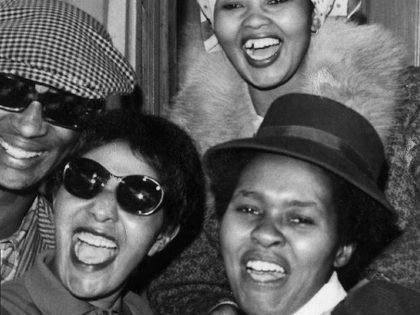An indispensable figure of African photography
Homage to Santu Mofokeng, photographer of quotidian black life in South Africa.

Santu Mofokeng's “Easter Sunday Church Service,” from Chasing Shadows (The Walther Collection).
After a long illness, Santu Mofokeng, a major figure of photography in South Africa, passed on January 26th 2020. He has been eulogized on social media in loving tributes by close friends and family. These tributes have shown him as a leader in his community, as well as within the family of visual artists and art practitioners, not only in South Africa but across various centers in the world. His now iconic photographs circulate the internet in the wake of his passing. We recall an incredibly influential, and indispensable figure of African photography.
Born Ntate Santu Mofokeng in 1956, he was raised in Soweto, the large township to the south of central Johannesburg. He was also educated in there, and grew up in the early days of legalized apartheid in South Africa. The official policy of racial segregation was made constitutional in 1948, and only declared void in the early 1990s. He was undeniably inspired by a broader visual black culture before, during and after apartheid. He was inspired by the traditional spiritual and linguistic cultures of black South Africans, and their photographic practices in the Victorian period. His work challenged the legal construction of blackness in law by following quotidian black life in Soweto, among many places.

While Mofokeng was arguable a pioneer, many artists in South Africa had depicted urban black life. These include the painters David Koloane, John Koenakeefe Mohl, Mmakgabo Helen Sebidi, Gladys Mgudlandlu, and the photographer Ernest Cole, alongside novelists such as Es’kia Mphahlele and Mariam Tlali. In this sense, his work is part of a history of art in the country made of refusals to conform to official or legal constructions of blackness. A history of artists that stubbornly pursued beauty in the midst of political and social malaise. Thus, how is the photographer and writer to be remembered?
Lekgetho Makola, director of Market Photo Workshop—which recently established the Santu Mofokeng Fellowship—emphasized his role as an artist and thinker “involved in the writing groups of the 1970s in Soweto during the rise of Black Consciousness thought among many youths then in the Townships of South Africa. He left us with his compelling and critically positioned consciousness in his images and text.” Elaborating on his model of thought, Gabi Ngcobo, international curator who previously worked on the 10th Berlin Biennial of Contemporary Art, said, “his philosophy was based on making instead of taking photographs; a philosophy that I understand as an extension or continuous journey towards our personal and collective freedoms, both imagined and real.”

Tumelo Mosaka, South African curator based in New York, said he was “a complicated and dynamic photographer whose poetic images and short stories captured eloquently the ongoing human struggle against existing inequalities,” while Emmanuel Iduma, Nigerian art critic, said his work was “a complete education in looking.” Similarly, John Fleetwood, notable curator of African photography, said he reminded us that “photography is a method of thinking.”
Before the Nigerian novelist Chimamanda Ngozi Adichie turned readers onto the “dangers of a single story,” Santu Mofokeng had taken up the mission to tell stories of black life that did not conform to the stereotypical agendas of news media. In a 2010 interview published in the African Cities Reader, he said, “I was never into victimology—I decided to do a project that is kind of a fictional biography or a metaphorical biography,” adding that, “I go to shebeens, I play football, not necessarily as a kind of lack but to show it for what it is.” In his disobedience to the trend of “victimology,” he took a radical approach to photography that advocated the complexity of aesthetic and spiritual dimensions of black life.
This philosophy is evident in two photographic series, Train Church, and The Black Photo Album / Look At Me (1890-1950). Writing on the earlier series that he started in 1986, he depicted his own observations of the everyday: “You arrive on Monday, you just want to sleep at two in the morning, you have been jolling, you’re hoping when you arrive in the train you can get some sleep … Two stations down the church begins and people start clapping hands and sing hymns, and then you find yourself in church” (2010).

Then, writing on the latter series which is a collection of personal photographs commissioned by black South Africans in the Victorian period he considered the idea of self-representation: “When we look at them we believe them, for they tell us a little about how these people imagined themselves” (1998). His shimmering and multifaceted black and white photographs drew attention to multifaceted stories, and experiences, ignored, if not disputed by the mainstream.
Santu Mofokeng’s career, which spanned decades, began in Soweto, where he practiced street photography. In 1985, he would establish the Afrapix Collective, alongside photographer Omar Badsha, among others. He would go on to work as a technician developing photography in the dark room, before being hired as staff photographer at the New Nation newspaper in 1987. Shortly thereafter he began working with the University of Witwatersrand as a researcher.
His renown international career came in the 1990s, with local exhibitions at the Second Johannesburg Biennial, and international group shows in Bamako, Mali, such as the first and second editions of the Bamako Encounters-African Biennial of Photography, and the São Paulo Biennial and Documenta 11, Kassel, both in 2002. Additionally, he had a retrospective solo exhibition at the renowned London photography center Autograph ABP in 2009, and received the prestigious Ernest Cole award at the International Center for Photography in New York.
Santu Mofokeng is survived by his wife Boitumelo and their two children.



